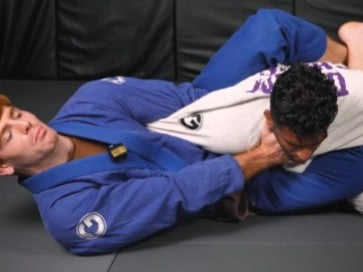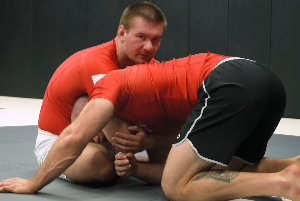Most Jiu Jitsu practitioners perceive the turtle as a defensive position. While Eduardo Telles (one of the most creative grapplers in the world) has popularized many attacks from the turtle position, the vast majority of your opponents are going to use the position to defend and work on reposing their guard.
In this lesson, Professor Rory Van Vliet shows us 6 sneaky ways to attack the turtle against a defensive opponent. He shows how to negate an opponent using turtle to prevent you from solidifying a pass, shut down your ability to secure points, or stopping you from being able to pin their hips or shoulders to the mat.
Basic Turtle Concepts
Before we get to specific turtle attacks, let's cover the basic concepts of the position.
Attacker’s Leg Positioning
Leg positioning is very important when attacking the turtle. Proper leg position prevents your opponent from getting a much better position and it also prevents them from transitioning from a defensive to an offensive position.
- Near leg right up against your opponent’s leg, while controlling the hips. This puts weight into your opponent’s body, and it prevents them from doing a Granby roll.
- The mirrored leg, where your knee is beside your opponent’s knee which gives you the ability to stay on top of your opponent and allows you to follow and stay on their back if your opponent moves away from you.

Opponent’s Alignment and Goals
When attacking the turtle, one of the important things we need to consider would be what would the opponent’s main defensive movement and recognize if the turtle position is legitimate. There’s going to be a part of figuring out where your opponent is on the stage of their turtle, good turtle players aren’t using the turtle as a position itself, they’ll be moving into it like a placeholder within positions.
As the attacker, we need to maintain control of the opponent’s hips as well as their upper body.
Proper Turtle Position:
- Dead Toes to lower the center of gravity, trying to get hip closer to heels
- Elbows on the inside of the knees
- Hand protecting the neck from chokes

Controlling the Upper Body
We need to maintain a rotational control of our opponent preventing them from being able to turn or being able to slow them down significantly which gives us time to react.
6 Sneaky Attacks
Attack #1: Ankle Lever Control
The Ankle Lever Control is one of the best moves to use when you already have the (1) seatbelt control. (2) Knock your opponent’s hips forward by bringing your knee under your opponent’s butt and bump him forward. (3) This move exposes their heel, catch it with your near leg. (4) Place your other knee in front of your opponent’s knee.

You now have the ratchet lever, where you’ll be able to rotate your opponent, insert one hook and finish with the second hook for the back-take points.

Attack #2: The Spiral Ride
The Spiral Ride is a great option when you can’t get the seatbelt control. Put your hand down to your opponent’s knee and use it as a lever to open him up. Your near leg should be blocking your opponent’s leg to prevent him from adjusting his post. Your other arm should be connected to your opponent’s bicep.

Start creating a circular motion by (1) leaning forward, (2) pull your opponent towards you, (3) move your hips backward and allow them to fall on the space in front of you. (4) This allows you to put one hook in, secure the seatbelt and (5) put the second hook in.

Attack #3: The Barrel Roll
One of the best ways to try and escape the turtle is to turn your back far away from your opponent so you’re making them travel a longer distance. In this attack, were going to look at following them and doing a barrel roll motion. Rather than trying to stop your opponent from moving, we need to follow them with control.
Establish proper (1) seatbelt control and heavy hip pressure. Jump over to the other side and keep your (2) knee mirrored to your opponent’s leg. Once your opponent drops, (3) he will be seated on your leg and this allows you to (4) insert one hook in while you pull your opponent to the other side to be able to (5) insert the second hook.

Attack #4: Following the Back
If you establish proper (1) seatbelt connections, that is your primary form of control of the back and you will be able to (2) follow the back without the hooks. From your back, make sure that your (3) legs are far away from your opponent’s legs to be able to (4) drive shoulder pressure on to your opponent’s neck. This breaks your opponent’s posture and prevents their ability to transition to reverse side control.

Walk your hips out and go to a belly-down north-south position, then build your base and turn your opponent up into a seated position.

Attack #5: Chasing a Seated Opponent
We need to be able to react to whichever direction our opponent turns. If your opponent turns to your weak side, it ends up opening your elbow away from your body and make it difficult for you to control your opponent. We need to make sure that we have the control on the proper side by moving your hips to the other side of your opponent’s body. Generate base from your legs, move your hips up and around your opponent and move to the other side, which is the strong side with proper seatbelt control.

Attack #6: Hooks vs a Seated Opponent
Here’s a sneaky way to enter your hooks if you have a seated opponent who is not turning either way and is keeping a tight elbow-knee connection.
Control your opponent’s wrist with a (1) motorcycle grip, (2) walk and create an angle that will allow you to (3) bring your knee in and driving it down to the mat. (4) Continue to turn yourself almost trying to turn and face your opponent. (5) Turn back and put yourself in with a (6) proper hook, establish a strong seatbelt connection, (7) pull your opponent to your strong side and put your second hook in.

Final Thoughts on Attacking the Turtle
When attacking the turtle, it's important to have strong fundamentals of back control so you have multiple options to control the position. The turtle is generally not a good position for the person on bottom - have confidence knowing that you are the dominant player, and you’ll be able to use these 6 attacks to break your opponent down and advance the position.
Want to Learn More?
These turtle attacks are part of Professor Rory van Vliet's "Attacking the Turtle" course on Gold BJJ Online Training. Sign up today to see the full course along with 25+ other courses from top instructors like Dean Lister:
Gear Featured in this Post
Professor Rory van Vliet is wearing our Aeroweave Ultralight Gi in black.



